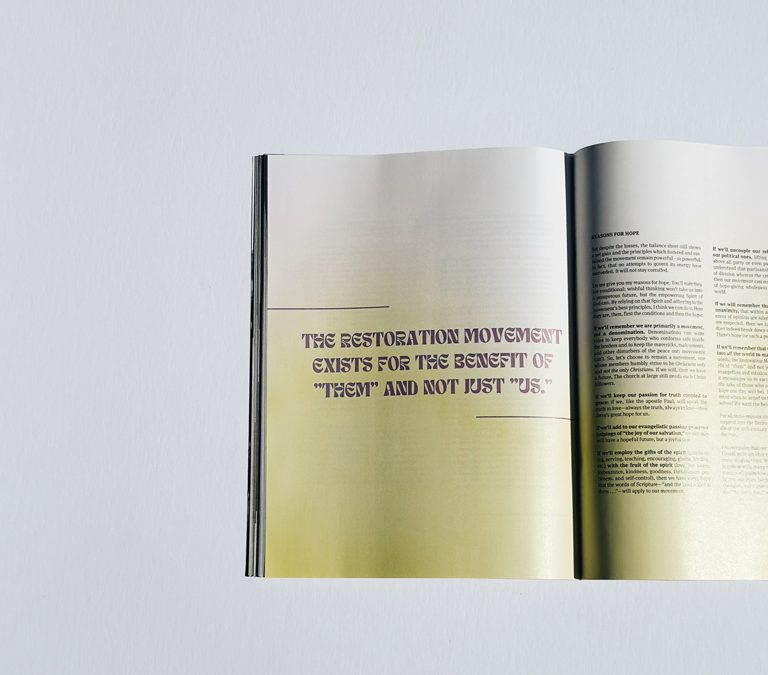By Jim Putman
It happened again. For the fourth time in a year, I received a call that another teenager in our area had committed suicide.
This time a man in our church called to tell me a friend’s son, a popular high school athlete, had ended his life. The man was devastated—he had just seen the young man the week before. The man was angry, and he said we had to do something!
My friend noted that in the old days, when kids were dying from driving intoxicated, the police and fire officials set up mock car wrecks that included actors playing devastated parents, to impress upon teenagers that drinking and driving wasn’t worth it. I listened and prayed with him, and we ended the call.
Just months before, a popular principal of the largest school in our area had committed suicide. In another incident, our staff team was invited to help the teachers and student body of a different school process a suicide by another young person. The superintendent of that school district shared with us that our state has one of the highest death by suicide rates in the country.
Around this time, a Netflix production called 13 Reasons Why only added to the problem. This fictional series showcased a teenage girl’s suicide and her stated reasons for taking her life. Teachers were alarmed by the popularity of the series. To get ahead of the situation, the teachers were looking to develop a program for their health classes designed to deal with teen mental health issues. In connection with all of this, our team had been thinking and praying for some time.
CONFRONTING THE LIES
As I drove down the road after that phone call, I wondered what would cause people to end their lives. I thought of the lies our culture has been telling us for decades and the impact it has on people’s hearts. Those lies originate with the father of lies, who has murder as his goal (John 8:44).
All of these things caused me to think about my wife. Before I met Lori, she had attempted suicide at age 16. Earlier in our relationship she had told me about her own “personal lies.” I asked her to share what she had told me years before.
Looking back at that time in my life, I remember the lies being so much bigger than me. The lies had become my truth, which is what led me to attempt suicide. The lie that I was stupid and had no future because I struggled with a learning disability. The lie that I was not important and my life didn’t matter because my boyfriend broke up with me. The lie that relationships didn’t work anyway because my parents were talking about divorce.
I remember feeling so hopeless and not wanting to take one more breath. I remember believing that everyone would be better off without me—then they could go on without having to deal with my problems. The voice in my head said, “You would be better off dead.” I remember trying to fight off the lies by myself, and because it wasn’t working, I tried to call someone else. My mom didn’t answer, the youth pastor wasn’t home, my friends weren’t either, which just told me I was right—I am a hassle.
In a moment of pain and with a desire to escape the weight [of it], I took the pills. I woke up in a hospital bed not knowing how I got there, [but] it was with the frustration of believing I had failed at something else. It was only then that I started the process of discovering that the thoughts in my head were all lies. Now I think about the lies others believe, and I want to help them fight those lies. It terrifies me to think of all I would have missed had I succeeded in taking my life.
As I pondered what Lori had shared, I began thinking of all the suicide notes I have read, all the conversations I have had with people who attempted suicide, and all the lies they told me they had believed. It dawned on me we could make a list of the most prevalent lies in those suicide notes. What if we could list those lies and expose their falseness to young people? What if we interviewed those who were impacted by suicide and had them share the truth of how they really felt about their departed loved ones? What if we could dispel the lies and show the true aftereffects of suicide?
RESPONDING TO THE PROBLEM
In that moment, I pictured the face of a friend in my men’s group. Caleb had produced movies in Hollywood (which was certainly unique for a person who lived in Idaho). Caleb had a production company and we had often talked about the possibility of partnering on a project. When I called and presented the idea to him, he immediately grew excited and said he absolutely would like to do it, and he would do it for cost.
Next, I called the superintendent of the public school to see what she thought. I had my doubts she would, or even could, partner with a church on something like this. I hoped all the work our church had done with the school system had built a bridge for this particular partnership, but I wasn’t sure.
Her response was amazing. She actually cried upon hearing the idea. She immediately promised to open up the school for the docuseries. She would allow us to interview the kids (with the parents’ permission, of course). She said the videos could be shown in health classes as part of their curriculum.
I was absolutely blown away.
I told the superintendent I understood the school had no money for this kind of project, but that our church would work with the production company to make it happen. She was ecstatic.
THE LORD PROVIDED
I called Caleb at the production company and told him the good news. But then came an unforeseen problem. I had not asked him what his “cost” meant on a project such as this, but now I did. His answer—about $150,000—floored me. It was a bargain deal in Caleb’s world but a disappointing shock in mine. I, of course, thanked him, but I told him it was more than the church could afford. I told him I would pray about it and share the idea with some others, but unless something happened, we were at a dead end.
Later, in the middle of my regular workday, a Christian friend who had helped us years earlier on a special church project called me. He shared that he felt like he was supposed to call me that day. He asked if there was some special thing on my mind that he could help with financially. I was blown away. I shared what had happened earlier in the day. He said, “Well, that answers my question—I want to help you pull that off.”
In less than a day, God had given us the idea, opened the door to a public school, and provided the production company and the money to do the project.
We immediately began planning the project. We set the date for an all-school assembly with junior high and high school students. I told the students about Lori’s attempted suicide and the lies she had believed. I shared about how my life would have been different, and worse, had she succeeded. I then shared what we believed were the five biggest lies people believed that led to death by suicide.
AN OVERWHELMING RESPONSE
We then told the kids that we would like to interview anyone who had attempted suicide, considered suicide, or been impacted by the death of someone in their life. We required the kids to get permission from their parents. We assumed that from among the 400 middle school children, we would get 20 or 30 interviews (especially because requiring permission slips meant kids would need to tell their parents they had considered suicide).
Staff at the school, our youth ministry team, and the production company were floored when 260 kids in that first school agreed to be interviewed. We anticipated that thoughts of suicide would be a major issue among young people, but it was even bigger than we expected. This was just the first of several schools in this school district we planned to meet with, and we were already overwhelmed.
As we sifted through the potential interviewees deciding who to interview on camera, we began the process of filming. It was an emotionally exhausting process. I am not exaggerating when I say the production crew required a group counseling session every evening after filming. The stories were heartbreaking.
SCHOOLS, YOUTH GROUPS, AND PARENTS
We decided our production required three tracks. The first needed to meet the requirements of the secular school system; it needed to expose the lies surrounding suicide without dealing with the spiritual influence of Satan and the Christian response. Another track would be for church youth groups; in this, we could really dive into how Satan works to create lies that end in death. The third track needed to increase awareness among parents about what was happening in the silence of their kids’ minds before it was too late.
Several kids who had attempted suicide had gone to churches in our area. In most cases these kids had suffered in silence. No one knew the depth of their struggles—and when they were discovered and discussed, it often changed the outcomes.
BRINGING TRUTH TO LIGHT
We discovered how social media was adversely affecting the mental health of kids. It resulted from too much screen time and a lack of relationships where kids can be truly honest. We discovered that ignoring the problem of mental health and suicide was not helping. The spiritual enemy was at work. Failing to discuss or address the problem was allowing thoughts of suicide to spread.
It’s time for society to wake up and pay attention to the root problem of suicide. Most importantly, the family of God needs to respond. The devil is a liar, and our kids are being lied to. And unfortunately, many kids believe those lies.
Parents and the church need to be proactive and realize we are called to raise children who can thrive in our war-torn world. We must remain alert and then respond to situations around us. We often are too distracted by unimportant things to pay attention to what matters. We can’t allow the lies to take root and become deadly. Our kids are irreplaceable.
The three videos we created are now available at RightNow Media’s website. Parents, churches, and even public schools have been using the material to start conversations about the lies so often hidden in our minds. Kids are being taught how to deal with these thoughts and how to get help. Parents are learning what to look for and how to start conversations that can rescue these families before tragedy strikes.
It was a massive undertaking to bring together the church, public school system, and mental health professionals in our area. The project revealed that a church can be a light in a community when we seek to use our resources to meet needs rather than to cast judgment. God has truly used this series, called Irreplaceable, to make a difference. I hope it helps your church and community, as well.
Go to RightNow Media to access the Irreplaceable resources.
Jim Putman serves as senior minister of Real Life Ministries in Idaho.





0 Comments